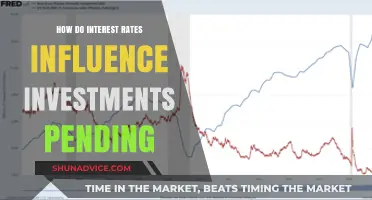
Navigating the stock market during a Federal Reserve interest rate cut can be a strategic move for investors. When the Fed lowers interest rates, it often signals an economic stimulus, potentially leading to a bull market. This is a good time to consider investing in growth stocks, as lower borrowing costs can encourage spending and investment, boosting corporate earnings. However, it's crucial to research and understand the specific sectors and companies that are likely to benefit the most from the rate cut. Diversification is key, so investors should consider a mix of sectors and asset classes to balance risk and reward.
What You'll Learn
- Market Impact: Understand how interest rate cuts affect stock, bond, and commodity markets
- Investment Strategies: Explore options like buying stocks, bonds, or real estate
- Risk Management: Diversify your portfolio to mitigate risks associated with rate cuts
- Economic Indicators: Monitor GDP, inflation, and unemployment data for investment insights
- Historical Precedents: Study past rate cuts to identify successful investment patterns

Market Impact: Understand how interest rate cuts affect stock, bond, and commodity markets
Interest rate cuts by the Federal Reserve (Fed) are a powerful monetary policy tool that can significantly impact various financial markets. When the Fed lowers interest rates, it triggers a chain of events that investors and traders should understand to make informed decisions. Here's an overview of how interest rate cuts influence stock, bond, and commodity markets:
Stock Market: Interest rate cuts often have a positive effect on the stock market. Lower rates make borrowing cheaper, encouraging businesses to expand and invest. This can lead to increased corporate earnings and, subsequently, higher stock prices. Investors may also view lower rates as a sign of economic stimulus, prompting them to buy stocks, especially in sectors like technology and consumer discretionary, which are often sensitive to interest rate changes. As a result, the overall market sentiment can improve, attracting more buyers and driving stock prices higher. However, it's important to note that not all stocks will react the same way; sectors like utilities and consumer staples might benefit more from lower rates due to their steady cash flows.
Bond Market: Bonds and interest rates have an inverse relationship. When the Fed cuts rates, bond prices typically rise. This is because existing bonds become more attractive as their fixed returns become relatively higher compared to the new lower rates. Investors seeking income may flock to bonds, driving up their prices. Additionally, the Fed's rate cut can lead to a decrease in the yield curve, making long-term bonds more appealing. However, this effect may be short-lived, as central banks usually signal future rate hikes, causing bond prices to fall and yields to rise in anticipation of higher interest rates.
Commodity Market: The impact of interest rate cuts on commodities is more complex. Lower rates can stimulate economic growth, which may increase demand for commodities like oil, gold, and agricultural products. This demand-side effect can drive commodity prices higher. However, the relationship is not always straightforward. For instance, if the Fed's rate cut is expected to lead to inflation, investors might shift their focus to commodities as a hedge against rising prices. On the other hand, if the economy slows down due to rate cuts, commodity demand could decrease, affecting prices negatively.
Understanding these market dynamics is crucial for investors during Fed interest rate cut scenarios. It allows for strategic decision-making, whether it's buying stocks, bonds, or commodities, or a combination of these assets. Investors should also consider the broader economic context and the Fed's communication to anticipate the potential duration and magnitude of the rate cut's impact.
Vanguard's Fixed-Income Options: A Comprehensive Overview
You may want to see also

Investment Strategies: Explore options like buying stocks, bonds, or real estate
When the Federal Reserve (Fed) cuts interest rates, it often signals a more favorable economic outlook and can present an attractive opportunity for investors to consider various strategies. During these times, understanding the potential impact on different asset classes is crucial to making informed investment decisions. Here's an exploration of investment strategies, focusing on stocks, bonds, and real estate:
Stocks: Lower interest rates can stimulate the economy, often leading to increased corporate profits. This makes stocks an appealing investment option. When the Fed cuts rates, it typically reduces the cost of borrowing, which can encourage businesses to expand, potentially boosting their earnings. Investors might consider buying stocks of companies in sectors that are likely to benefit from easier borrowing conditions, such as consumer discretionary, technology, and healthcare. A strategy could be to research and invest in companies with strong growth prospects and a history of dividend payments, as these can provide a steady income stream during periods of economic expansion. Additionally, index funds or exchange-traded funds (ETFs) that track the performance of a specific market index can be a diversified approach to investing in stocks during a rate cut environment.
Bonds: Interest rates and bond prices have an inverse relationship. When the Fed cuts rates, bond prices tend to rise, making bonds an attractive investment. Investors seeking a more conservative approach might consider purchasing government bonds, corporate bonds, or municipal bonds. Government bonds, in particular, are often seen as a safe haven during economic uncertainties. As interest rates fall, the fixed returns from bond investments become more attractive compared to the potential volatility of other asset classes. Bond funds or ETFs can also provide diversification, allowing investors to gain exposure to various bond markets without buying individual bonds.
Real Estate: Real estate investments can be a valuable addition to a portfolio during a period of low interest rates. When the Fed cuts rates, mortgage rates often follow suit, making it more affordable for individuals to purchase homes. This can lead to increased demand for real estate, potentially driving up property values. Investors can consider buying rental properties or real estate investment trusts (REITs), which are companies that own or finance income-producing properties. REITs offer the advantage of diversification across multiple properties without the need for direct real estate management. Additionally, real estate investment trusts often provide regular dividends, making them an attractive income-generating asset during a rate cut scenario.
In summary, during a Fed interest rate cut, investors have the opportunity to explore various strategies. Stocks, with their potential for capital appreciation and dividend income, can be a powerful investment choice. Bonds, especially government and corporate bonds, offer a more conservative approach with rising prices and fixed returns. Real estate investments, through properties or REITs, can benefit from lower mortgage rates and increased demand. It is essential to conduct thorough research, consider individual risk tolerance, and diversify across different asset classes to build a well-rounded investment portfolio during these economic conditions.
Understanding Investment Interest Expense: A Comprehensive Guide
You may want to see also

Risk Management: Diversify your portfolio to mitigate risks associated with rate cuts
When the Federal Reserve (Fed) cuts interest rates, it can significantly impact the investment landscape, often leading to a surge in borrowing and spending. While this can stimulate the economy, it also introduces certain risks that investors should be aware of. One of the primary strategies to navigate these risks is through portfolio diversification. Here's how you can approach it:
Understanding the Impact of Rate Cuts: Before diving into diversification, it's crucial to comprehend the effects of interest rate cuts. Lower rates typically make borrowing cheaper, encouraging businesses and consumers to take out loans. This can lead to increased spending and investment, potentially boosting stock markets. However, it may also result in higher inflation, which can erode the value of fixed-income investments. Additionally, rate cuts can lead to a shift in market sentiment, causing certain sectors to outperform while others may lag.
Diversification Strategies: Diversification is a cornerstone of risk management. Here's how you can diversify your portfolio during a rate cut scenario:
- Asset Allocation: Reassess your asset allocation strategy. Consider increasing your exposure to stocks, especially in sectors that tend to benefit from lower interest rates, such as consumer discretionary and technology. These sectors often thrive in a low-interest-rate environment as consumers have more disposable income to spend.
- Fixed-Income Portfolio: If you have a fixed-income portfolio, consider adjusting it to include a mix of government bonds and corporate bonds. Government bonds are generally considered safer during economic stimuli, while corporate bonds with higher credit ratings can provide some protection against inflation.
- International Investments: Explore international markets, especially those with strong economic fundamentals. Diversifying globally can help reduce the impact of domestic economic policies and provide exposure to different growth opportunities.
- Alternative Investments: Consider adding alternative investments like real estate investment trusts (REITs), commodities, or even cryptocurrencies. These assets can act as a hedge against traditional market movements and provide portfolio diversification.
Regular Review and Rebalancing: Market conditions change rapidly, especially during periods of monetary policy shifts. Therefore, it's essential to regularly review and rebalance your portfolio. Set up periodic assessments to ensure your asset allocation aligns with your risk tolerance and investment goals. This process allows you to buy or sell assets to maintain your desired level of diversification.
Risk Assessment and Monitoring: As you diversify, continuously monitor the performance of your investments and the broader market. Stay updated on economic indicators and news related to interest rates and their potential impact on your holdings. Regular risk assessments will help you make informed decisions and adjust your strategy accordingly.
By implementing a diversified portfolio, investors can effectively manage the risks associated with Fed interest rate cuts. This approach ensures that your investments are not overly exposed to any single market or asset class, providing a more stable and balanced approach to navigating economic stimuli. Remember, diversification is a long-term strategy, and it may take time to see the full benefits, especially during volatile market periods.
Unlocking Compound Interest: Strategies for Continuous Growth Without Initial Capital
You may want to see also

Economic Indicators: Monitor GDP, inflation, and unemployment data for investment insights
When the Federal Reserve (Fed) cuts interest rates, it's a significant economic event that can impact various sectors and industries. Monitoring key economic indicators becomes crucial for investors to make informed decisions during such times. Here's a detailed guide on how to use GDP, inflation, and unemployment data to gain valuable investment insights:
Gross Domestic Product (GDP): GDP is a comprehensive measure of a country's economic health and represents the total value of goods and services produced over a specific period. During a Fed interest rate cut, investors should closely observe GDP growth rates. A rising GDP indicates a robust economy, which can attract investors as it suggests a healthy demand for goods and services. This environment often favors investments in consumer-facing sectors like retail, hospitality, and automotive. Conversely, a declining GDP might signal economic weakness, prompting investors to reconsider their exposure to cyclical industries.
Inflation: Interest rate cuts are often employed to combat inflation, which measures the general rise in the price level of goods and services. When the Fed reduces interest rates, it aims to stimulate borrowing and spending, potentially leading to increased inflation. Investors should monitor inflation data to understand the trajectory of price levels. High inflation can erode the value of fixed-income investments, so investors might consider shifting their portfolios towards assets that can outpace inflation, such as real estate investment trusts (REITs) or inflation-indexed bonds. On the other hand, low inflation or deflationary pressures might encourage central banks to further stimulate the economy, benefiting certain sectors.
Unemployment Rate: The unemployment rate is a critical indicator of the labor market's health and overall economic stability. During a Fed interest rate cut, investors should pay attention to changes in unemployment data. A decreasing unemployment rate suggests a strengthening job market, which can lead to increased consumer spending and higher corporate profits. This environment often favors investments in sectors like retail, technology, and consumer discretionary. Conversely, a rising unemployment rate may indicate economic challenges, prompting investors to reevaluate their positions in more defensive sectors like utilities, consumer staples, or healthcare.
By monitoring these economic indicators, investors can make strategic decisions aligned with the economic conditions created by the Fed's interest rate cuts. It's essential to analyze these data points in conjunction with other factors, such as industry-specific trends, company fundamentals, and global economic events, to build a comprehensive investment strategy. Additionally, staying informed about the Fed's communication and future policy decisions is vital, as it provides further context for interpreting economic data.
Understanding Investment Interest: A Comprehensive Guide for Investors
You may want to see also

Historical Precedents: Study past rate cuts to identify successful investment patterns
To navigate the complexities of investing during a Federal Reserve (Fed) interest rate cut, it's crucial to delve into historical precedents and study past rate-cutting cycles. These periods offer valuable insights into successful investment strategies and can guide your decision-making process. Here's a detailed exploration of how to approach investing in the context of Fed rate cuts:
Understanding the Historical Context:
Past rate cuts by the Fed have often been catalysts for economic recovery and market growth. By examining these historical instances, you can identify patterns and trends that have historically preceded successful investments. For example, during the 2008 financial crisis, the Fed implemented aggressive rate cuts, leading to a surge in stock markets as confidence returned. Similarly, in 2019, the Fed's rate cuts in response to economic uncertainties resulted in a robust market rally.
Identifying Asset Classes:
- Stocks: Historically, rate cuts have often been followed by stock market rallies. This is because lower interest rates can stimulate economic growth, leading to increased corporate profits and higher stock prices. Sectors like technology, consumer discretionary, and healthcare have often shown resilience during and after rate cuts.
- Bonds: While bonds may not experience the same dramatic rise as stocks, they can still benefit from rate cuts. As interest rates fall, bond prices tend to rise, providing investors with higher yields. Government bonds and investment-grade corporate bonds are often preferred during these periods.
- Real Estate: The real estate market can also benefit from rate cuts. Lower mortgage rates make borrowing more attractive, potentially increasing property values and rental demand. Real estate investment trusts (REITs) can be a good proxy for investing in this sector.
Investment Strategies:
- Diversification: Diversifying your portfolio is a prudent approach during rate cuts. Allocate assets across different sectors and asset classes to mitigate risk. For instance, consider a mix of growth-oriented stocks, income-generating bonds, and real estate investments.
- Long-Term Perspective: Rate cuts are often part of a broader economic recovery process. Adopting a long-term investment horizon can be beneficial. Focus on companies with strong fundamentals and growth potential, as they are more likely to thrive in a low-interest-rate environment.
- Stay Informed: Keep a close eye on economic indicators and Fed communications. Understanding the rationale behind rate cuts and their potential impact on various markets is essential. This knowledge will enable you to make informed decisions and adjust your portfolio accordingly.
- Risk Management: While rate cuts can be positive for the market, they may also introduce short-term volatility. Implement risk management techniques such as stop-loss orders and regular portfolio rebalancing to protect your capital.
By studying historical rate cuts and their subsequent market performance, investors can make more informed choices. This approach allows for a strategic allocation of resources, taking advantage of the opportunities presented by lower interest rates while managing potential risks. Remember, a well-researched and diversified investment strategy is key to success during these periods.
Understanding the Frequency of Interest Compounding on Your Investments
You may want to see also
Frequently asked questions
A Fed interest rate cut is a decision made by the Federal Reserve to lower the target interest rate, which influences the cost of borrowing money throughout the economy. This action is typically taken to stimulate economic growth, encourage borrowing and spending, and combat economic downturns or recessions.
During a Fed interest rate cut, the stock market often reacts positively. Lower interest rates can make borrowing cheaper for businesses, potentially increasing their profits. Additionally, lower rates may attract more investors to the stock market as it becomes more attractive compared to fixed-income investments like bonds, which offer lower returns when interest rates fall.
Here are some strategies to consider:
- Stock Market: Buying stocks can be a good strategy as companies may benefit from lower borrowing costs, leading to increased profitability.
- Growth Stocks: Focus on companies with strong growth potential, as they are more likely to thrive in a low-interest-rate environment.
- Technology and Innovation: Sectors like technology, healthcare, and renewable energy often perform well during rate cuts as they are driven by innovation and future-oriented thinking.
- Real Estate Investment Trusts (REITs): REITs can benefit from lower interest rates, making borrowing cheaper for property purchases and development.
While interest rate cuts can present opportunities, there are potential risks to consider:
- Market Volatility: Interest rate cuts can sometimes lead to increased market volatility as investors adjust their strategies.
- Inflation: Lower interest rates might encourage more spending and borrowing, potentially leading to higher inflation, which could erode the value of investments over time.
- Economic Uncertainty: Rate cuts are often a response to economic challenges, and the underlying issues may persist, impacting the long-term health of the market.
Timing investments is a complex task and should be based on your financial goals and risk tolerance. Here are some points to consider:
- Research and Analysis: Stay informed about economic indicators, market trends, and the Fed's communication to make informed decisions.
- Diversification: Diversify your investment portfolio across different asset classes to manage risk.
- Long-Term Perspective: Consider a long-term investment strategy, as short-term market fluctuations are common during such events.
- Consult Professionals: Seek advice from financial advisors who can provide personalized guidance based on your unique circumstances.







